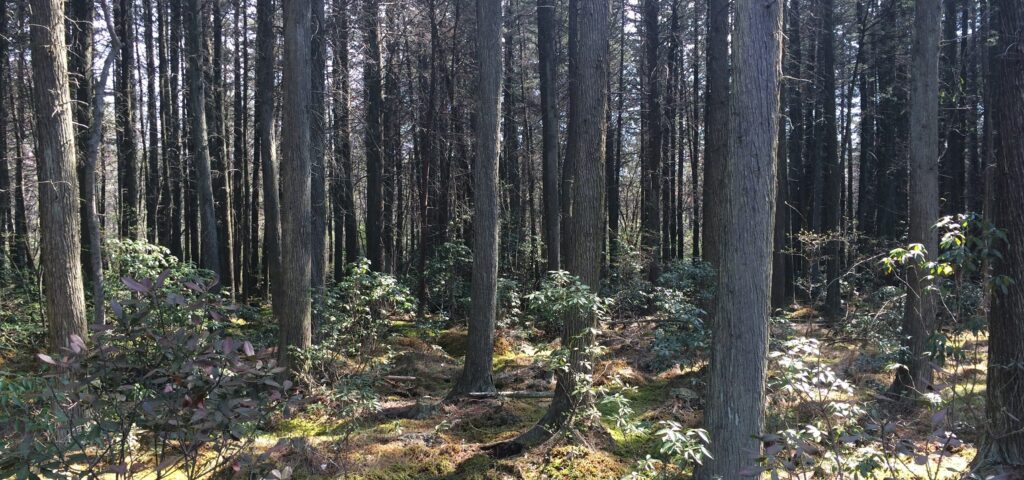The State We're In
10,000 acres of Atlantic white cedar forest to be restored
By Michele S. Byers, Executive Director, 1999-2021
Step into a mature stand of Atlantic white cedar trees on a hot day and you’ll instantly feel cooler. These towering native evergreens grow so dense that they shade out sunlight and create forest floor habitat for ferns, sphagnum moss, liverworts, insect-eating plants, rare orchids and swamp pinks. In turn, this incredible forest supports rare animals like Pine Barrens tree frogs, barred owls and timber rattlesnakes.
Before European settlement, there were about 500,000 acres of Atlantic white cedar forest up and down the East Coast. New Jersey alone had about 115,000 acres of cedar in the Pine Barrens and Meadowlands.
But Atlantic white cedars have suffered a double whammy.
In colonial New Jersey, cedar forests were relentlessly chopped down for their strong, lightweight, rot-resistant timber, prized as a building material. The heartwood was so durable that even logs submerged in swamps for centuries could be turned into excellent lumber.
Cedar wood was used for shipbuilding and shingles for roofs and siding. Unfortunately, in the wake of logging, cedar forests often regenerated into maple, gum, and pine swamps due to overabundant deer or altered water tables from nearby agriculture, beaver dams, or road crossings with improper culvert pipes.
Today, Atlantic white cedar forests face the modern threat of climate change. Storm surges and rising sea levels caused by the warming climate are inundating many coastal Atlantic white cedar forests with saltwater, killing the trees. The “ghost forests” left behind are the subject of a haunting art installation at Madison Square Park in New York City through Nov. 14, featuring a stand of dead cedars from an inundated swamp in the New Jersey Pine Barrens.
Today, less than 25,000 acres of Atlantic white cedar forest remain in New Jersey. But there’s new hope for these magnificent trees!
The New Jersey Department of Environmental Protection recently announced plans to restore 10,000 acres of Atlantic white cedar forest over the coming decade, mostly on state-owned lands in the Pine Barrens.
“This is the largest forest restoration project ever undertaken in New Jersey and the largest ever in the nation restoring Atlantic white cedars,” said NJDEP Commissioner Shawn LaTourette. “Through this project, we will reestablish once-dominant stands of Atlantic white cedar, but at higher elevations less vulnerable to rising seas and saltwater intrusion and provide habitat for globally rare plants and wildlife, while capturing and storing carbon and absorbing floodwaters.”
Restoration efforts will be funded through the Department of Environmental Protection’s Natural Resource Damage recovery program.
“We’re looking to put about 10,000 acres of cedar back on the landscape,” State Forester John Sacco explained in a video accompanying the announcement. “Funding will come from damage recoveries against companies that polluted the public’s groundwater. This project will go a long way in restoring the groundwater injuries.”
The ecological benefits abound:
- Sacco has called Atlantic white cedar swamps “the kidneys of the Pine Barrens” for their exceptional ability to filter and absorb pollutants from water.
- Cedar swamps hold stormwater and release it slowly, regulating the hydrology of the region.
- Cedar forests serve as efficient carbon “sinks,” absorbing carbon from the atmosphere and storing it in trees and in the organic peat soil that these forests generate. Restoring Atlantic white cedar forests is a great example of a “natural climate solution,” one of many opportunities to protect and enhance carbon stored in forests, wetlands and agricultural soils.
- Pine Barrens wildlife will benefit. A rare butterfly known as Hessel’s hairstreak is exclusively dependent on Atlantic white cedar swamps. State-threatened barred owl nests there, and state-endangered timber rattlesnakes hibernate there in winter. Many other animals use cedar swamps to stay cool in the summer and find cover in the winter.
- The restoration will improve the connectivity of the Atlantic white cedar ecosystem and create natural breaks needed for wildfire control.
There’s every reason to believe the state’s ambitious project will be successful. New Jersey already has pulled off several Atlantic white cedar restorations, both on state and privately-owned land.
For example, in 2007 New Jersey Conservation Foundation converted 1,100 acres of abandoned cranberry bog in the Pine Barrens to wetlands. The following year, NJ Conservation volunteers and staff planted 25,000 tiny Atlantic white cedar seedlings on 80 acres. Today these trees are about 12 feet tall, the beginning of a majestic forest that could live for hundreds of years.
To learn more about the state’s Atlantic white cedar restorations plans and watch a video, go to www.nj.gov/dep/parksandforests/forest/atlanticwhitecedar/.
To see some of the budding Atlantic white cedar forest for yourself, visit New Jersey Conservation Foundation’s Franklin Parker Preserve in the Pine Barrens and take a stroll along the Yellow Trail. To see a trail map, go to https://www.njconservation.org/wp-content/uploads/2018/11/FranklinParkerTrailMap-color.jpg.
And for information about preserving New Jersey’s land and natural resources, visit the New Jersey Conservation Foundation website at www.njconservation.org or contact me at info@njconservation.org.
About the Authors
Alison Mitchell
Co-Executive Director
John S. Watson, Jr.
Co-Executive Director
Tom Gilbert
Co-Executive Director, 2022-2023
Michele S. Byers
Executive Director, 1999-2021
View their full bios here.
Filter
Get The Latest News
From The Garden State
In the
News

